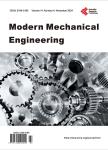Thermal-Mechanical Coupled FE Analysis for Rotary Shaft Seals
作者机构:Department of Machine and Product DesignBudapest University of Technology and EconomicsBudapestHungary
出 版 物:《Modern Mechanical Engineering》 (现代机械工程(英文))
年 卷 期:2018年第8卷第1期
页 面:95-110页
学科分类:1002[医学-临床医学] 100214[医学-肿瘤学] 10[医学]
主 题:Coupled FE Analysis Thermal-Mechanical Coupling Rotary Shaft Seals NBR Rubber Viscoelasticity
摘 要:The aim of this paper is to model the steady-state condition of a rotary shaft seal (RSS) system. For this, an iterative thermal-mechanical algorithm was developed based on incremental finite element analyzes. The behavior of the seal’s rubber material was taken into account by a large-strain viscoelastic, so called generalized Maxwell model, based on Dynamic Mechanical Thermal Analyses (DMTA) and tensile measurements. The pre-loaded garter spring was modelled with a bilinear material model and the shaft was assumed to be linear elastic. The density, coefficient of thermal expansion and the thermal conductance of the materials were taken into consideration during simulation. The friction between the rotary shaft seal and the shaft was simplified and modelled as a constant parameter. The iterative algorithm was evaluated at two different times, right after assembly and 1 h after assembly, so that rubber material’s stress relaxation effects are also incorporated. The results show good correlation with the literature data, which state that the permissible temperature for NBR70 (nitrile butadiene rubber) material contacting with ~80 mm shaft diameter, rotating at 2600/min is 100°C. The results show 107°C and 104°C for the two iterations. The effect of friction induced temperature, changes the width of the contact area between the seal and the shaft, and significantly reduces the contact pressure.



